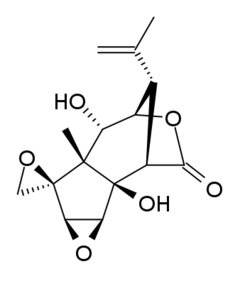Tutin (toxin)
 | |
| Clinical data | |
|---|---|
| ATC code |
|
| Identifiers | |
| |
| CAS Number | |
| PubChem CID | |
| ChemSpider | |
| ECHA InfoCard |
100.236.780 |
| Chemical and physical data | |
| Formula | C15H18O6 |
| Molar mass | 294.299 g/mol |
| 3D model (JSmol) | |
| |
| |
| (verify) | |
Tutin is a poisonous plant derivative found in New Zealand tutu plants (several species in the Coriaria genus). It acts as a potent antagonist of the glycine receptor,[1] and has powerful convulsant effects.[2] It is used in scientific research into the glycine receptor. It is sometimes associated with outbreaks of toxic honey poisoning when bees feed on honeydew exudate from the sap-sucking passionvine hopper (Scolypopa australis) insect, when the vine hoppers have been feeding on the sap of tutu bushes. Toxic honey is a rare event and is more likely to occur when comb honey is eaten directly from a hive that has been harvesting honeydew from passionvine hoppers feeding on tutu plants.[3]
References
- ↑ Fuentealba J, Guzmán L, Manríquez-Navarro P, Pérez C, Silva M, Becerra J, Aguayo LG. Inhibitory effects of tutin on glycine receptors in spinal neurons. European Journal of Pharmacology. 2007 Mar 15;559(1):61-4. PMID 17303114
- ↑ Zhou H, Tang YH, Zheng Y. A new rat model of acute seizures induced by tutin. Brain Research. 2006 May 30;1092(1):207-13. PMID 16674929
- ↑ Background on toxic honey. New Zealand Food Safety Authority.
This article is issued from
Wikipedia.
The text is licensed under Creative Commons - Attribution - Sharealike.
Additional terms may apply for the media files.